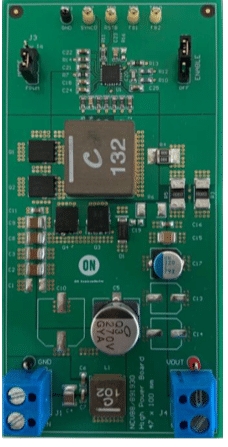This reference design not only fulfills a variety of functional requirements but also underscores the adaptability and efficiency of using advanced MOSFET technology in conjunction with a dedicated controller for automotive power systems.

The reference design TND6290/D by onesemi provides a detailed, functional example of how the NCV881930 controller can be effectively utilized in developing a high-performance automotive pre-regulator. The design is not only a testament to the capabilities of the controller but also serves as a reliable blueprint for designers looking to implement a similar solution in their automotive systems. T
This reference design of a 100 W non-isolated synchronous buck automotive pre-regulator is built using the NCV881930 synchronous buck controller, complemented by four NVMFS5C460NL 40 V N-channel MOSFETs, to deliver robust and efficient power management suitable for a wide range of automotive applications. These features include integrated compensation which simplifies circuit complexity, a low quiescent current that enhances battery life, and a continuous synchronous mode for better efficiency under varying load conditions. The controller supports a wide input range from 6.0 V to 16.0 V, effectively managing peaks up to 40 V, which is critical for handling automotive voltage fluctuations.
The design operates at a 410 kHz switching frequency, optimizing it for maximum efficiency without sacrificing performance. The choice of the NVMFS5C460NL MOSFETs complements the controller by supporting the high-frequency operation and ensuring reliable handling of high current loads. This combination not only maximizes efficiency but also minimizes the PCB size, as evidenced by the small form factor four-layer PCB used in this design.It is designed to operate with an input voltage range of 6 V to 16 V DC, capable of handling peak voltages up to 40 V. It features a synchronous buck output power topology with a capacity of up to 100 W. The output voltage is regulated at 5.0 V, providing a nominal current of 15.0 A and can handle peak currents up to 20.0 A. This design makes it a versatile and robust solution for automotive power regulation needs.
Overcurrent protection safeguards the device against excessive currents that could damage the circuitry. An external synchronization feature allows the regulator’s operation to be synchronized with other components in the system, reducing electromagnetic interference. The adaptive non-overlap drivers help minimize switch cross-conduction losses, while the integrated spread-spectrum capability reduces EMI emissions. Furthermore, the under-voltage lockout feature ensures the regulator operates within safe voltage levels, protecting both the circuit and the connected load.
This design is intended as a plug-and-play solution for power supply designers, allowing for easy adoption with minimal modifications required to suit specific system needs. The versatile nature of the design makes it suitable for a broad spectrum of automotive applications, from basic power supply roles to more complex electronic system integrations.
Onesemi has tested this reference design. It comes with a Bill of Material (BOM), schematics, a Printed circuit board (PCB) layout, and other data. You can find additional data about the reference design on the company’s website. To read more about this reference design, click here.
The post 100W Non-Isolated Synchronous Buck Automotive Pre-Regulator Reference Design appeared first on Electronics For You.
View more at https://www.electronicsforu.com/electronics-projects/100w-non-isolated-synchronous-buck-automotive-pre-regulator-reference-design.
Credit- EFY. Distributed by Department of EEE, ADBU: https://tinyurl.com/eee-adbu
Curated by Jesif Ahmed